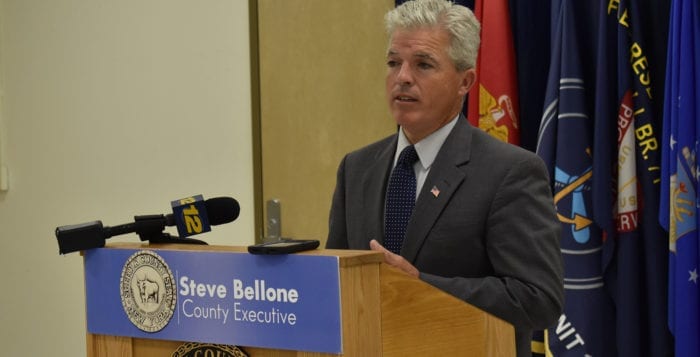County working toward compromise on lump bonding issue

Though the fight over lump bonding in the Suffolk County Legislature is not over yet, both parties are looking to find common ground.
County Executive Steve Bellone (D) announced the county would be offering un-lumped bond resolutions for the next legislative session July 17, after a series of bond-seeking bills for various projects were voted down on a party-line vote last month.
“Unfortunately we have seen the creeping into Suffolk County of national style politics that has delivered abuse in Washington – which is a shame because we haven’t had that in Suffolk, particularly when it comes to funding of critically important and even routine capital projects,” Bellone said. “I want to move us back towards the way we have operated in the past where we treat these kinds of important bonds in a nonpartisan way.”
Bellone mentioned several bond resolutions that will be up for vote come July 17. One includes funding for repaving on Commack Road from Julia Circle to Route 25A and along Crooked Hill Road from Henry Street to Commack Road. Two other major projects include $2 million in funding for licensing the Rave Panic Button mobile app, a police and rescue emergency application for school and government employees, and $8.82 million in funds for the Rails to Trails project that will establish a trail from Wading River to Mount Sinai on grounds that used to host train tracks.
Ninety-four percent of Rails to Trails is funded by federal grants that will be paid back to the county after the project is completed. Legislator Sarah Anker (D-Mount Sinai), the driving force behind the project, said if the bond doesn’t pass the county could miss the August deadline to get access to those federal grants.
“We have already invested $1 million with a design and engineering plan that we will have to reimburse if this bond does not pass,” Anker said. “We are ready to put a shovel in the ground, even at the end of this year.”
“I want to move us back towards the way we have operated in the past where we treat these kinds of important bonds in a nonpartisan way.”
— Steve Bellone
The legislature needs to vote “yes” on both an appropriations bill as well as one to approve bond funding to support capital projects, and for weeks the two parties in the legislature have battled over bundled bonds. Bellone has said the Republican minority was hypocritical if it voted for the project’s appropriations but voted against the funding. Republicans were against any lump bonds because they did not want to feel forced to vote on items they might disagree with in the future, lumped with items they were comfortable supporting now.
Because the legislature requires 12 of the 18 members to pass a bond vote, the seven-member Republican minority have joined together during the past two legislative meetings to shoot down any lump bonds.
Bellone said he would be going forward with legislation that would require both appropriations and bonding be included in one single vote, but Presiding Officer DuWayne Gregory (D-Amityville) said the Legislative Counsel has questioned the legality of that idea, with appropriations requiring 10 votes and bonds needing 12.
Instead, Gregory said he instructed the county clerk to write up the next week’s meeting agenda to have bonds be voted on before appropriations.
“If the bond resolution fails then the appropriation doesn’t come up for a vote,” Gregory said. “It limits the opportunity for somebody to vote for it before voting against it … Hopefully it takes the politics a little bit out of it.”
Republicans in the legislature see the move away from lump bonding as a victory.
“We’re happy that the County Executive has agreed to go back to individual bond resolution for several bonds,” Minority Leader and Legislator Tom Cilmi (R-Bay Shore) said. “We’re looking forward to working forward with the County Executive over the coming months to find some common ground.”
Though Cilmi said he and other Republican legislators are happy the bonds will not be lumped together, he still has misgivings about a few of the projects, especially when it comes to county finances.
“There are certain proposals where we agree with the project, but we believe the funding for the project should come out of operating funds rather than going out and borrowing money to do it,” Cilmi said. “The county is $2 billion in debt, and we have to exercise restraint in how we go out and borrow money.”






